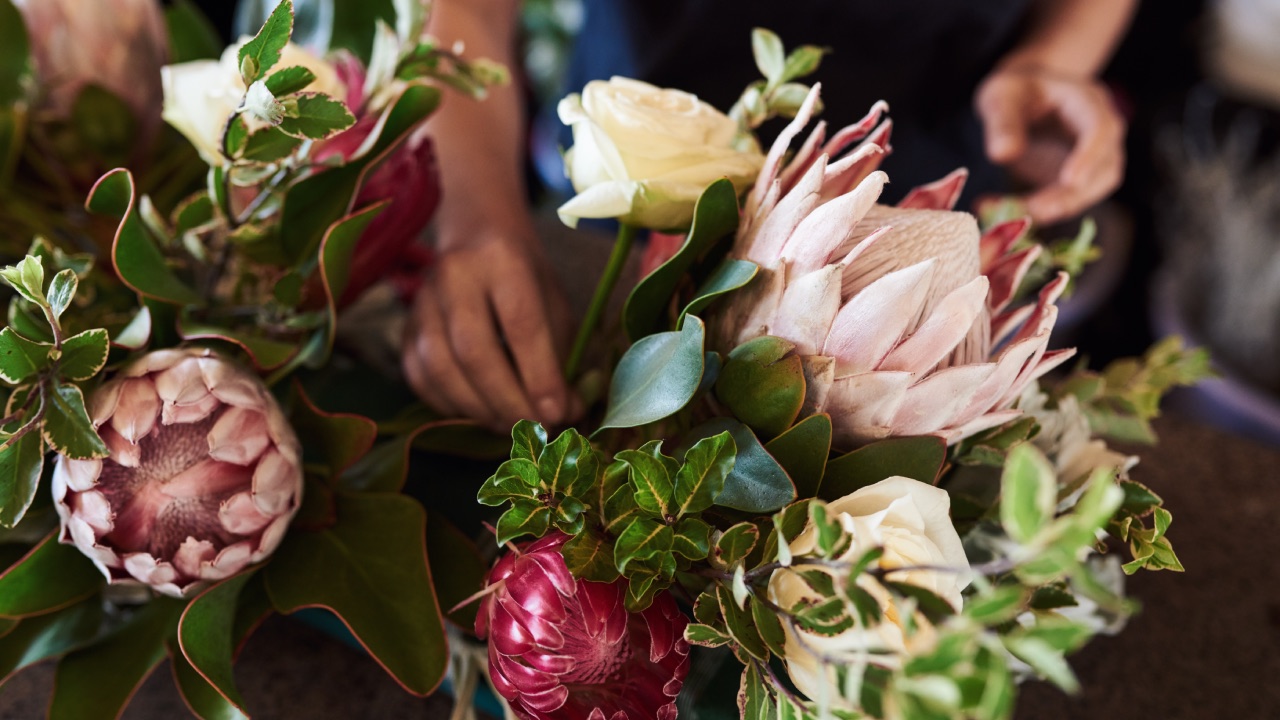How to create your own flower arrangements

Flowers are a sure-fire way to make just about anyone’s day. Whether you’re giving them as a gift, using them to decorate you house or making a centrepiece for an occasion, flowers will instantly brighten with their beauty. Here are some tips for creating your own flower arrangements at home.
Look for inspiration
With Pinterest, Twitter, Facebook and Instagram, inspiration for flower arrangements is now literally endless. Magazines and books are also a great source for ideas.
Select a colour scheme
When deciding on a colour scheme for your flower arrangement, there are a few things to consider. Firstly, is it an arrangement to go in a vase in your home and if so, what are the colours of the room it is going in? Or perhaps it is a gift for a friend and if so, what’s the occasion? Lastly, what time of year is it? These factors will influence what you go for. If the arrangement is for a house then you’ll need to pick colours that suit the room. If it is for an occasion, you’ll want to consider if you need bright and happy colours, or something more subtle. Lastly, if it's summer, it’s best to opt for colours that celebrate that time of year.
Write up a recipe
Prepare a recipe for your floral arrangements, just as you do when making a meal. Include tools and supplies needed, the amount of flowers and go from there. If you're making an arrangement for home, you’ll likely just need the bucket, vase, a couple of tools for grooming the flowers (see below). For a bouquet, you’ll need all of that minus the vase and add in some ribbon and string, or if you’re after a centrepiece, you will also need a block of floral foam and a votive to make your arrangement in. It’s always a good idea to buy a few more flowers than you think you’ll need. A standard flower arranging supply tool kit would include: clippers, floral tape, ribbons, floral moss, flower preservative, rose strippers if you have roses, and vases. Once you have your recipe, you'll know what you need.
Off to the market
You have a few options when it comes to where to buy your blooms: you could start in your own garden if you’re on a budget, otherwise there are lots of wholesale flower markets, or grocery stores, store front florists, farmer’s markets and mail order. We recommend heading to wholesale markets. The produce comes straight from farms, the variety is amazing and you can generally get the best value for your money. Keep in mind that in order to get the best flowers from the markets, you’ll have to get there early and some markets open at 4 or 5am. Check what markets are closest to you.
Pick your flowers
Peonies or gardenias, roses or carnations, orchids or irises? It is best to select flowers according to the time of year and what’s in season. Out-of-season flowers are likely to be harder to come by and expensive. There are some places in which you can pre-order, so it might be worth a phone call to discuss your options. Otherwise, just Google what you’re interested in and see what's in season where you live and make your plan around that. When you’re at the market or store, make sure the flowers you buy are not beginning to wilt. Ideally, there should be a few green buds in the mix and petals should feel firm and have no brown edges.
Grooming
First you need to pick out any dead or broken blooms and petals. Next, you need to cut each stem by at least one inch at an angle using a sharp knife, scissors, or clippers. Then it is very important to get them into some water. Buckets work well to keep them in and a tall bucket in which the stems can gently rest on the sides will work best. The fewer leaves left below the waterline in the vase the better as leaves steal nutrients from blooms and can also cause the water to get nasty faster. Be sure to pull of the extra greenery. Most flowers (except tulips and hyacinths) do best in lukewarm water.
Caring for your flowers
Keep the water fresh and change daily to keep the flowers healthy. It’s also good to trim the stems periodically to help them stay hydrated.
Step-by-step guide to flower arranging
1. Begin by placing two or three more branchy stems into the vase (or in your hand if you're making a bouquet) as this will help you get an idea of the overall shape you want your arrangement to take. You want to create a sense of width as well as height, so really work those angles.
2. Now start adding the attention-grabbing blooms one at a time, again at different heights. Try placing one big bloom right on the edge of the vase, and one at least an inch or two higher. If it looks like your arrangement is growing a set of eyeballs, snip one of the stems.
3. Turn your vase often and consider working from different angles. Even if you vase ends up in a corner or against a wall when you’re done, you want it looking good from all sides.
4. Go slowly and don’t be afraid to take things out if it’s not working. Keep going, adding alternate colours, sizes and shapes. Mix foliage and greenery with vivid hues, ensuring you don’t damage them. When you feel like you’re done, try adding two or three longer gestural stems (ranunculus or anemones) at an unexpected height or angle to pump up the drama.
Image credits: Getty Images
